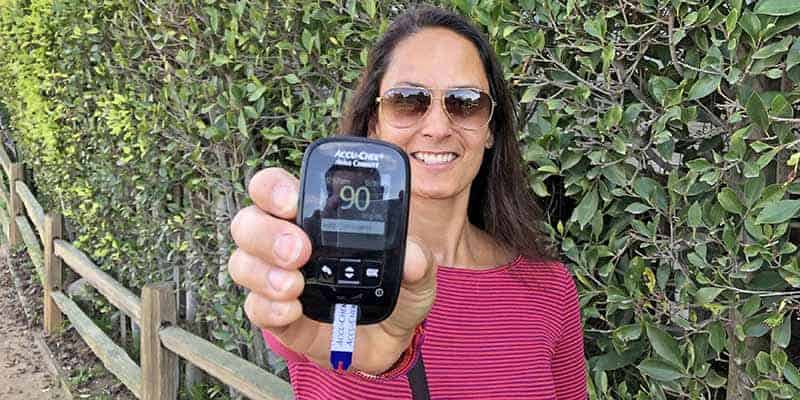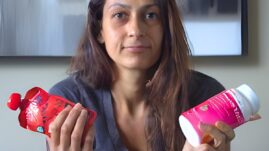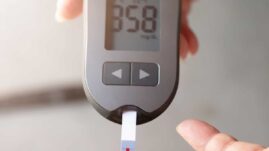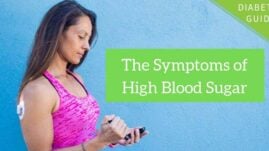Your blood glucose (sugar) levels are a critical part of your overall health and your body’s ability to function properly.
For those of us with diabetes, striving to achieve “normal” blood sugar levels is a constant, hour-by-hour pursuit. And it isn’t easy.
In this article, we’ll look at normal blood sugar levels and goal ranges for people without diabetes and recommended blood sugar goals for people with prediabetes, type 1 diabetes, and type 2 diabetes.

Table of Contents
- Normal blood sugar ranges in people without diabetes (chart)
- Recommended blood sugar ranges in people with diabetes (chart)
- How do you know what your blood glucose level is?
- Diagnosing prediabetes, type 1, and type 2 diabetes
- Your A1c and blood sugar goals
- Your blood sugar isn’t just because of what you eat
- Final thoughts: Still frustrated with your blood sugar and A1c results?
Normal blood sugar ranges in people without diabetes (chart)
For a person without any type of diabetes, blood sugar levels are generally between 70 to 99 mg/dL (3.9 to 5.5 mmol/L) fasting and under 140 mg/dL (7.8 mmol/L) after a meal.
Here are the normal blood sugar ranges for a person without diabetes according to the NIH:
| Fasting Blood Sugar (e.g., In the Morning Before Eating) | Less than 100 mg/dL (5.6 mmol/L) |
| 1 to 2 Hours After a Meal | Less than 140 mg/dL (7.8 mmol/L) |
| 2 to 3 Hours After a Meal | Less than 100 mg/dL (5.6 mmol/L) |
Recommended blood sugar ranges in people with diabetes (chart)
Here are the generally recommended blood sugar ranges for a person with diabetes according to the ADA:
| Fasting Blood Sugar (e.g., In the Morning Before Eating) | 80 to 130 mg/dL (4.4 to 7.2 mmol/L) |
| 1 to 2 Hours After a Meal | Less than 180 mg/dL (10.0 mmol/L) |
Learn more about fasting and after-meal blood sugar levels in: Blood Sugar Chart: Blood Sugar and A1c Targets.
How do you know what your blood glucose level is?
Unless it’s fairly high or low, you generally can’t feel what your blood sugar level is. And in fact, you may not even be able to tell from physical symptoms when it is high or low.
The best way to know your blood sugar level is to either check it with a traditional glucose meter or use a CGM (continuous glucose monitor) device.
For a glucose meter, you do a finger-stick with a lancet, put a drop of blood onto a test strip, and then insert the strip into the meter for a reading. With a CGM, readings are taken from the interstitial fluid (the fluid between the cells) about every 5 minutes via a sensor inserted just under the skin.
Diagnosing prediabetes, type 1, and type 2 diabetes
The following are tests that may be used by your healthcare provider to determine if you have diabetes:
Tests used to diagnose diabetes
Fasting plasma glucose test
This test measures your glucose level at a single point in time, typically after you have been fasting (nothing to eat or drink except water) for at least 8 hours.
Random glucose test
This test measures your glucose level at a single point in time and may be given at any time, whether you have fasted or not.
Oral glucose tolerance test (OGTT)
For this test, you will have a blood sample taken after fasting for at least 8 hours. Next, you will drink a liquid high in sugar and will have another blood sample taken after 2 hours to see how your blood glucose levels have changed.
(In those who are pregnant, glucose will be checked every hour for 2 to 3 hours to test for gestational diabetes.)
A1c test
This blood test reflects your average glucose levels over the previous 2 to 3 months. You can eat and drink prior to having an A1c test.
A repeat of these tests is typically required to confirm a diabetes diagnosis.
Test results for diagnosing diabetes (chart)
The following blood sugar and A1c results (a measure of glucose control over the previous 2 to 3 months) are used to diagnose prediabetes and diabetes, according to the ADA:
| A1c | Fasting Glucose | 2 Hours After a Meal | |
| Prediabetes | 5.7 to 6.4 percent | 100 to 125 mg/dL (5.6 to 6.9 mmol/L) | 140 mg/dL to 199 mg to dL (7.8 to 11.1 mmol/L) |
| Diabetes (type 1 or type 2) | 6.5 percent or higher | 126 mg/dL (7.0 mmol/L) or higher | 200 mg/dL (11.1 mmol/L) or higher |
Learn more about diagnosing diabetes in: Types of Diabetes.
Please note: Type 1 diabetes tends to develop very quickly, which means that by the time symptoms are felt, blood sugar levels are often well above 200 mg/dL all the time. For many people, symptoms come on so quickly that they are dismissed as a lingering flu or another seemingly ordinary virus.
By the time blood sugar levels are checked, many people with undiagnosed type 1 diabetes may have levels above 400 mg/dL or higher.
If you suspect that you or a loved one has type 1 diabetes, visit your primary care or urgent care immediately and ask for a urine test to measure ketones in addition to checking blood sugar levels and A1c.
Read more about ketones at diagnosis in: How to Avoid Diabetic Ketoacidosis (DKA).
Your A1c and blood sugar goals
Managing any type of diabetes is far more complicated than giving a person some insulin and telling them to keep their blood sugars within X and X mg/dL. If you’ve lived with diabetes for more than a few days, you probably already know this.
What is A1c?
“A1c, also known as hemoglobin A1c, HbA1c, glycated hemoglobin, or glycohemoglobin, is a blood test that measures your average blood sugar over the last 2 to 3 months,” explains Christel Oerum, MS, in Diabetes Strong’s guide to lowering your A1c.
Although the test reflects the glucose attached to hemoglobin (the protein in your red blood cells) over the past 2 to 3 months, the blood sugar levels in the 2 weeks leading up to your A1c test influence the results the most. Essentially, higher blood sugar levels during this period result in more glucose binding to hemoglobin.
Translating your A1c to a blood sugar level
Using this simple calculator from the ADA, you can translate your most recent A1c result to an “eAG,” or “estimated average glucose level.”
You can also use this translation when working to improve your A1c and achieve closer to normal blood sugar levels.
For instance, if you know an A1c of 6.0 percent equates to an average blood sugar level of 126 mg/dL (7.0 mmol/L), then you can look at your current blood sugar results on your CGM and meter and pinpoint what time of day you’re frequently higher than that level.
| A1c | eAG |
| 6 percent | 126 mg/dL |
| 7 percent | 154 mg/dL |
| 8 percent | 183 mg/dL |
| 9 percent | 212 mg/dL |
| 10 percent | 240 mg/dL |
| 11 percent | 269 mg/dL |
| 12 percent | 298 mg/dL |
Normal blood sugar levels in a person without diabetes can result in an A1c of 5.6 percent or lower.
Just a decade or two ago, it was rare for a person with type 1 diabetes to achieve an A1c result below 6.0 percent.
Thanks to new and improved insulin and better technology like CGMs, smarter insulin pumps, and hybrid closed-loop technology (which allows some insulin doses to be automatically delivered), more people with diabetes are now able to safely achieve A1c levels in the higher 5 percent range.
Why your A1c matters
In a nutshell: Your A1c is one of the clearest indicators of your risk for developing diabetes complications like neuropathy (nerve damage), retinopathy (a type of eye disease), nephropathy (kidney disease), cardiovascular disease, and severe infection in any part of your body that requires healing.
For instance, a small cut on your toe could become infected due to high blood sugars, struggle to heal, and become severe enough that the infection could require an amputation.
The general guidelines from the ADA recommend an A1c level of less than 7.0 percent to help prevent diabetes-related complications. Lowering your A1c closer to 6.0 percent may further reduce the risk of microvascular complications (those impacting the small blood vessels), such as those affecting the eyes (retinopathy), kidneys (nephropathy), and nerves (neuropathy).
Some people with diabetes aim for A1c levels in the 5s and lower — especially those who follow strict low-carb diets like the ketogenic diet and the Bernstein diet. However, this hasn’t been proven in research as especially necessary, nor is it reasonably achievable for the larger population of people with diabetes.
It’s also important to remember that your blood sugar levels and your A1c are just information that tells you whether your body needs changes in factors like insulin, other diabetes medications like metformin, your nutrition, or your physical activity.
If you don’t like the number you’re seeing on your glucose meter or your A1c results, use that number as motivation to make changes (with the support of your diabetes healthcare team) in how you safely manage your diabetes in order to get different results.
Determining the right A1c goal for you
Just because a blood sugar range of 70 to 130 mg/dL (3.9 to 7.2 mmol/L) is considered the healthiest for people with diabetes doesn’t necessarily mean that’s the appropriate goal range for you — especially if you have type 1 diabetes, or take insulin as a person with type 2 diabetes.
The reason this may not be the right goal for you is that extremely tight blood sugar management in people taking insulin can potentially lead to frequent hypoglycemia (low blood sugar), which can be dangerous.
Achieving extremely tight blood sugar management also generally requires a strict nutrition plan, very frequent blood sugar monitoring, precise medication management, and, often, years of experience studying your blood sugar levels.
Your A1c goals should be set in close consultation with your medical team, who can help balance the benefits and risks of different targets based on your health status, lifestyle, and preferences.
Older adults with cognitive or functional limitations or severe comorbidities (major additional health issues) may have a less-stringent A1c goal of less than 8 percent.
It is also worth noting that your A1c targets can change over time as your diabetes management evolves.
A1c goals should be individualized
“A1c goals should be individualized based on the individual capabilities, risks, and prior experiences,” explains Gary Scheiner, MS, CDCES, founder of Integrated Diabetes and author of Think Like a Pancreas.
“For example, we generally aim for very tight A1c levels during pregnancy and more conservative targets in young children and the elderly.”
Scheiner highlights important factors that could justify aiming for a higher A1c, like hypoglycemia unawareness, a condition in which a person with diabetes no longer feels the typical warning signs of low blood sugar.
Hypoglycemia unawareness can put you at significant risk for severe low blood sugars that have the potential to be life-threatening. To reduce that risk, you would aim for higher target blood sugar ranges.
“Someone with significant hypoglycemia unawareness and a history of severe lows should target higher blood glucose levels than someone who can detect and manage their lows more effectively,” adds Scheiner.
“And certainly, someone who has been running A1cs in double digits [like 10 percent or higher] for quite some time should not be targeting an A1c of 6 percent … better to set modest, realistic, achievable goals.”
Read about reducing your A1c in: How to Lower Your A1c and How to Lower A1c Naturally.
Your blood sugar isn’t just because of what you eat
It’s easy to believe that your blood sugar levels are impacted only by what you eat and how much you exercise, but people with type 1 and type 2 diabetes who check their blood sugars frequently could tell you otherwise.
It’s especially important to keep this in mind when looking at your own blood sugars and your goals, because there are certain variables and challenges that impact blood sugar levels that you can’t always control.
For example:
- Menstrual cycles: often raise blood sugar and insulin needs
- Adrenaline rushes from competitive sports, heated arguments, roller coaster rides, and other intense situations: raise blood sugar and insulin needs
- The common cold and other illnesses: usually raise blood sugar and insulin needs
- Hormonal changes due to puberty and healthy growth in young adults: raise blood sugar and insulin needs
- An injury that increases overall inflammation levels: raises blood sugar and insulin needs
- Gluconeogenesis during anaerobic exercise: raises blood sugar and insulin needs
While you can’t necessarily prevent these factors that affect your blood sugar from occurring, you can work with your diabetes healthcare team to adjust your insulin, other diabetes medications, nutrition, and activity levels to help compensate for them when they do occur.
For example, when engaging in anaerobic exercise such as weightlifting, many people with type 1 diabetes find it necessary to take a small bolus of insulin prior to or during their workout because anaerobic exercise can actually raise blood sugar.
Final thoughts: Still frustrated with your blood sugar and A1c results?
Your blood sugars and your insulin or medication needs never stay in one place. If you gain weight or lose weight, your insulin and medication needs will change. If you become more active or less active, your needs will change. If you make drastic or even small changes to your nutrition, your needs will change.
Working with your diabetes healthcare team and diabetes coaches who can teach you how to make changes in your overall diabetes management plan is essential. Diabetes is a lifelong learning process.
Take a deep breath and be patient. If you don’t like what you’re seeing on your glucose meter, don’t get mad … get studying! Take good notes and work with your team to make changes to reach your goals.





bernie martinez
on April 22nd i got told by doctor i am diabetic . i have started walking ,stopped drinking cokes and drinking a lot of more water,stopped eating white breads sweet candies, flour tortillas corn tortillas and eating more fruits . i am 1 month into this, i hope this is a good start ?
Christel Oerum
Sounds like you’ve attached this head-on. Cutting out sugary drinks and walking more is excellent! Depending on what works best for you, you probably won’t need to cut out all carbohydrates from your diet but can enjoy them in moderations. Same thing with fruit, it’s an excellent type of food, but for some people, the carbohydrate content from large amounts is more than their body can process
Ravi
I am 55 year old and pre-diabetic and hyper-tension patient from India. I am regularly taking Amlodipine 5mg for blood pressure in night.
I see frequent change in my blood sugar reading which is my concern. We monitor it using Accu Chek device.
In morning 7:00 reading is near to 80-90. I take breakfast at the same time and go for a walk around 3000-4000 steps and at 11:00 my suger level is 90 again. I feel tension in my nerves and dizziness. Is it normal? I eat and gets normal. But this cycle repeat after every 3-4 hours.
Is it normal to feel sensation in my body if the blood level is 90 ?
Thanks
Ravi
Sensation as well as weakness in my body….
Christel Oerum
Hi Ravi,
From what you describe it sounds like you’re doing a good job managing your blood sugars. The symptoms you describe does sounds concerning and if possible I’d suggest you discuss them with you, doctor, as soon as possible. Might bot be diabetes related
Leigh
I really appreciated this article! I was diagnosed with Type 2 diabetes about 9 years ago and have never really had any education on what to do or what is happening to my body, except here take these pills, try all the new injectables and lose weight. I recently discovered Dr. Jason Fung and his success with reversing type 2 diabetes in his patients by using a low carb diet and intermittent fasting. He wrote a book called the Obesity Code. Anyway, I have been working on eating low carb and exercising since last June and have lowered my A1c from 9.0 to 6.2 at my last lab visit. I don’t hear too much about reversing type 2 diabetes except in the keto community. My goal is to reverse my type 2 diabetes and be off meds by my 50th birthday next year. Is this something that you have seen as achievable in your experience?
Christel Oerum
Some people can achieve non-diabetic blood sugars through nutrition and diet. You can read more here: https://diabetesstrong.com/is-type-2-diabetes-reversible/
Lisa Crow
Why would I have a blood sugar of 45 almost an hour after eating breakfast of eggs toast coffee and a few hash browns? I thought food brings it up. Most of the time my heart races and I feel sick after I eat. Then when that happens it’s 147 or more. The doctors are saying I’m having Barriactric weight loss surgery complications. I’ve also had pancreatitis. I thought you ether have low or high but mines all over the place.
Christel Oerum
I would suggest you discuss that with your doctor. If you have gastroparesis that can impact how fast or slow food is digested and therefore how fast it hits your bloodstream (https://diabetesstrong.com/diabetic-gastroparesis/)
Rajesh
Hello i am 36 yrs old male
I had done first time my sugar readings
My sugar fasting was 77 mg/dl
HbA1C was 5.7
eAG was 116.89 mg/dl
I just did this casually.
Are these reports ok?
What should i do to further improve?
Christel Oerum
You’d have to have a doctor review your labs and guide you. He’ll look at your family history and your other labs as well.
aleiza D.
I’m a few weeks short of being 66. About a year and a half ago, I had my first A1C at 6.3. I went on Metformin which set me into pancreatitis. I went on glimiperide which caused rapid weight gain. I have been on Januvia now for approximately 6 months. My c-peptide has been 0.9 and 1.6 consecutively.
This morning my blood sugar was 82. I rode my bike 50 miles today and took a leisurely neighborhood walk (keeping distance). I decided to check my blood sugar 2 hrs after dinner. It was 177. Not sure why it went up so much. My dinner was not anything unusual. My March endocrinology appointment was canceled secondary to Covid. My next appointment is mid-July. Suggestions? Ideas? Should I try to get an earlier appointment?
Christel Oerum
If you continue to see higher numbers than you’d expect I’d suggest getting an earlier appointment. This one reading could have been a one-off, or your liver could have released extra glucose if you weren’t hydrated or had eaten enough. But again, one reading doesn’t tell you much, however, if you see significant high blood sugar patterns or measure ketones in your urine you should react quickly
Aleiza D
thank you.
Kristen L. Fitzgerald
I’ve had diabetes T1, since 2002 secondary to chronic pancreatitis, I am now 48yo, on an insulin pump and have other health issues that have an effect on the diabetes. I wanted to thank you so much for all the information and guidance and support you offer. I exercise and eat well, but it is a daily balance and struggle. Your topics always seem to come to my email at the right times! Your research and perspective on it all shines through!! Ty again for letting us know, we’re not alone and that it’s ok to “stumble” on the path… ty ty ty
Christel Oerum
Thank you! I’m so happy to hear that.
And you’re definitely not alone, we’re all in this together
Pamela
I had my diabeties under control until I fell exercising and broke my shoulder in 4 places and had to have reconstructive surgery. I also broke my ankle. I was 65 when this happen and its been 1 1/2 years now and I have not recovered. I have gained 25 pounds, my sugar is running 175 to 200 all the time, I have been diagnosed with gastropaaresis, have hyperthyroidism that goes back and forth to hypo then hyper. I cannot exercise because I both my ankles have been broken from balance problems and they don.t support me without pain after 5 minutes of walking.
I have an endocronologist, cardiologist, pulmonary specialist and I just cannot seem to recover. I used to run 2 miles a day b4 I broke my ankle/shoulder. I was fit and not even pre diabetic, even though I suffered from severe sleep apnea and necrosis of the hip (which was replaced), I felt great. Now metformin causes headaches and terrible nightmares that make me severly depressed about life. I don’t even know where to begin, who to turn to, anymore.
I know Im blessed that I dont suffer from cancer but I feel I need to seek other help.
Christel Oerum
You do have a lot going on and it’s not surprising that it’s overwhelming, frustrating and I’m guessing a lonely journey at times. I think I would focus on what you can control. You can’t exercise but you can control your diet. So maybe spend some time learning about good nutrition and find what works for your body. Your endo might have a good nutritionist you can lean on and we have a lot of recipes and nutrition ideas here on the website
Tom Rintelmann
Pamela,
I can relate to your circumstances. My heart ached when reading your post. Our difference being I was diagnosed with type 1 Diabetes the summer after graduating high school in 1978.
I remained active throughout my life and was my Doctors ‘poster boy’, due to my A1C levels ranging from 5.7 to 6.1. In 1976 I had all the cartilage removed from my R knee due to a sking accident. At the age of 55 I sufferred several life changing events. My right shoulder required Rotator Cuff surgery. Like you I was inactive for weeks, (my R knee also lost all meniscus) and pain meds masked the damages. At 57 my L shoulder mirrored the left and I felt like you described in your post. Poor sleep patterns, surreal dreams and awakening to a sense of no control. Depression set in.
Having someone to speak to and a strong sounding Board made me realize I was the same person as before. To that end I was able to take small steps each day to regain my health. Diabetes Strong has been a good site to read and to regain my balance.
You are not alone. Find a good listener and find a marker to achieve ‘One Day at a Time’.
All the best,
Tom
NB
Tom,
What a fantastic story…swim, bike and continue to push humanity along with you !!!
Paul Jones
TAKE UP CYCLING ITS LOW IMPACT AND EASIER ON THE ANKLES.
I HAVE LOST 30 KG IN THE PAST 24 MONTHS BY DAILY EXCERCISE AND DIET CHANGES – MORE VEGETABLES AND LESS RED MEAT AND VERY LITTLE DAIRY.
HAVE PATIENCE AND THE RESULTS WILL COME!
D Anderson
I just wanted to thank you for writing this. I let myself go for a while but for the last few weeks I’ve been straightening things out. Often my blood sugar is higher than I anticipated it would be, and as a result I’m averaging about 140 on my glucose tests despite eating few if any carbs. It’s good to be reminded that there’s simply more to it than that.
Sharjeel
I had my blood sugar checked by a small machine from a friend. I had lunch approx 5 hours earlier than the test and the reading was 100
I wotkout at the gym or home around 2-3 times a week as well
Am I safe?
Or should I be worried about something?
Christel Oerum
You can tell anything from one data point. If you’re worried I suggest you see a doctor and get more thorough blood work done. Call your doctor but my guess is that she/he would tell you to not worry about a 100 mg/dl reading